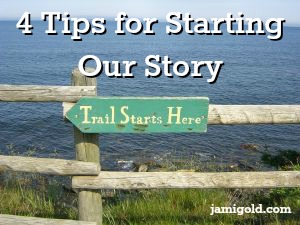Tomorrow, thousands of writers will start their novel for National Novel Writing Month (NaNoWriMo). I’m not in a good spot in my writing project schedule to participate this year (*pout*), but I’m cheering from the sidelines. (I’m Jami Gold if anyone wants to buddy me.)
On this occasion, I wanted to bring together several tips from my previous posts about story openings to ensure everyone has a successful start. Here in one place, find the top advice from some of my posts about story openings…
Tip #1: What Impression Do You Want Readers to Have?
We can start our story thousands of ways. To narrow down our choices, we need to figure out what we want to accomplish: What impression do we want the reader to have from our beginning?
Stories are about change, so if we know something about how our story ends (based on our story’s premise or climax), we know what kind of contrast to set up at the beginning. We can think about that ending and brainstorm ideas about what sort of beginning would show the change we want for our theme.
That might mean we figure out how to lead into the story’s main conflict. Or how to show the character in the situation that would kick off the right emotional arc and theme.
(See more about the steps we can go through to find our story beginning: Happy New Year! Let’s Talk (Story) Beginnings.)
Tip #2: What Opening Scene Leads to the Rest of the Story?
Now we need to tie that big-picture concept into the rest of the story. This need for a connection between the opening scene and the story itself is a major reason why many prologues don’t work.
Whether it’s part of a prologue or not, an opening scene should:
- have a similar point-of-view (POV) style as the rest of our story (i.e., not omniscient unless the rest of the story is),
- at least give hints to how this event ties into the main story and characters (i.e., how this event can/will affect them),
- present a problem, dilemma, or choice to act as a “now what?” hook for the reader,
- start at the scene when something first happens that will drag the protagonist into the main story conflict,
- be directly relevant to the story now (i.e., not just backstory), and
- feel like a concrete, specific scene that makes sense and has context.
Opening scenes aren’t about setting up the character and their situation. Beginnings are about setting up elements of the story’s conflicts. Readers will learn about the character and their situation along the way.
That means we have to decide how we’re going to get from Point A (the opening image) to Point B (the Inciting Incident that kicks off the story). Often this means trying to move Point A as close to Point B as possible, starting just before something happens to the protagonist that forces a change or decision.
(See more about prologues: A Prologue Will Help Our Story When…)
Tip #3: What Will Interest the Reader on the First Page?
Instead of looking at story openings as writers, we need to look at them from a reader’s perspective. We have to make them curious about our characters, their situation, their problems, and their world with those first words.
Sometimes we can do that with voice alone, just as some people in real life have amazing charisma. But even if we’re that talented, ensuring we have interesting characters and situations will never hurt.
Creating interesting characters doesn’t mean readers want a physical description or a dry backstory of the character’s tale of woe. Readers want to see characters in action, showing who they are, their strengths and weaknesses, and what matters to them.
Creating interesting situations doesn’t mean we have to show action-filled conflict. In fact, the conflict on a first page doesn’t even have to involve a character. The conflict can be within the reader, between what they expect and the words on the page. Hints of impending issues or a gap between the expected and the reality tell readers there’s something to look forward to, that there’s a story there.
That’s curiosity. Readers will keep reading to find out what will happen next and to learn the answers to their questions. Human nature wants to fill that knowledge gap—and keep reading.
(See more about first pages: What Makes a Great First Page?)
Tip #4: What Doesn’t Belong in Our Thinking Process?
All that said, we’ll rarely come up with the perfect beginning—much less a perfect first page—while drafting. Even if we know everything about the story arc and opening scene, we might emphasize the wrong elements.
Rather than obsessing over that, we just need to get the draft close and then fix it in revisions. By the time we finish drafting the story, we’ll know the right tone and thematic messages to emphasize. Then we can use feedback about character likability and reader interest to tweak the details.
During drafting, our definition of a “good” beginning should simply be for the story to head in the right direction. If we start with an older sister going through a divorce in a black comedy, and we later discover the story is really about the younger sister heading to college in a tragedy, we’ll have to scrap most everything we write.
Whereas, if our story starts off in the right direction, we can almost always fix it in revisions. (*psst* If you need assistance with those fixes, that’s where a “book doctor” can help.) So have enough of a plan to get a good start, but don’t stress about perfection. *smile*
How much do you think about and plan your story beginnings before drafting? Which element do you struggle with the most? How much do you worry about first lines and first pages? If you’re doing NaNo this year, are you ready?

